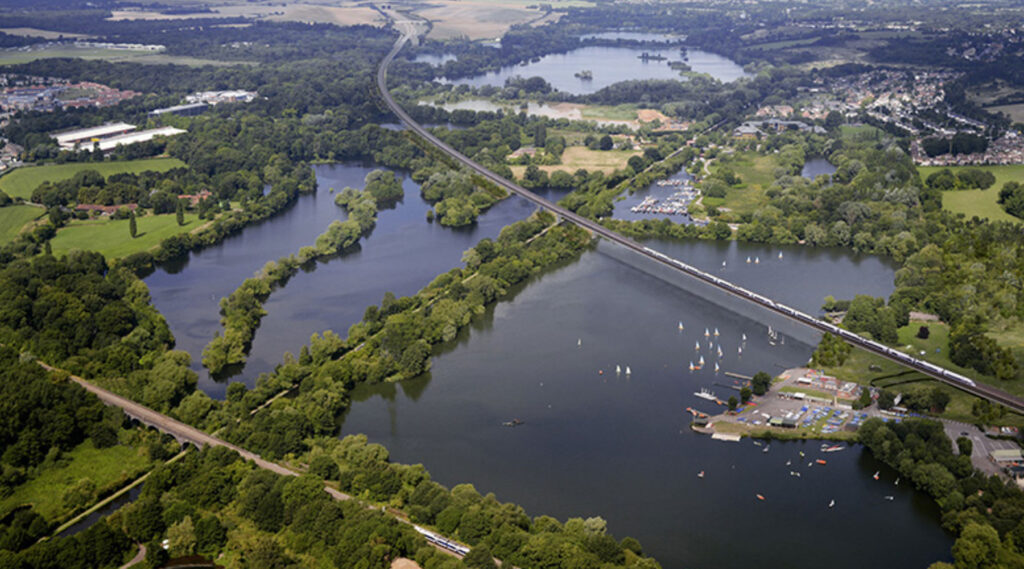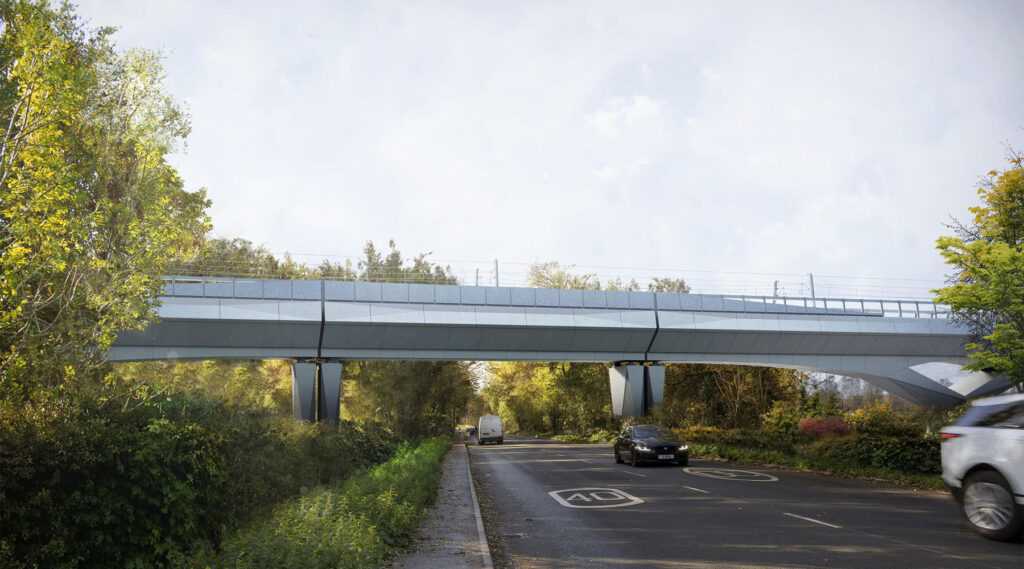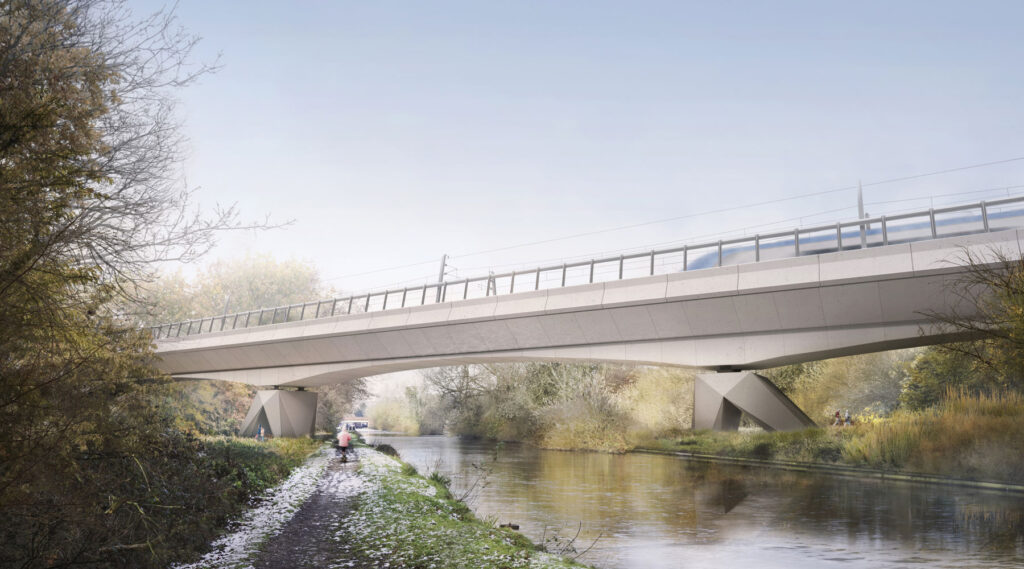Construction work has started on what will be the UK’s longest railway viaduct, and it’s to be built in north-west London for HS2. The HS2 railway emerges from tunnels alongside the mainline railway at West Ruislip, before curving northwards over the Colne Valley on a long sweeping viaduct.
A number of designs were looked at, including a dramatic cable-stayed bridge which would have meant fewer piers in the ground, but a far greater visual impact from a distance. The current design is aimed to be sleek and glide across the landscape without being intrusive on it from a distance, while also being visually appealing up close.
The final design is by Grimshaw, based on a design by Knight Architects.
Apart from the concrete design, one of the notable aspects is that where was once proposed a concrete sound barrier running along the sides was replaced with a translucent one, which gives train passengers a view of the valley and reduced the bulk of the viaduct height.
Some of the viaducts spans will be as much as 80 metres long, carrying the railway around 10 metres above the surface of the lakes, River Colne and Grand Union Canal. The structure will be supported by 56 piers, with the widest spans reserved for where the viaduct crosses the lakes, and narrower spans for the approaches.
Over the next year, engineers will construct 292 piles under the ground to support the viaduct piers. On top of each group of piles – some of which will go up to 55m into the ground – a concrete pile cap will support the pier which will, in turn, support the full 6,000 tonne weight of the bridge structure above.
Instead of hammering the piles into the ground, holes will be bored before being backfilled to create the pile. An extensive programme of test piling has already been completed with engineers sinking 12piles at two locations with geological and structural data from these tests fed back into the design of the viaduct.
The main deck of the viaduct will be built in sections at a temporary factory nearby before being assembled from north to south.
When completed, at 3.4km long, it will be longer than the Forth Rail Bridge.










I am not an engineer but I have always wondered, could not the ‘sound’ created by fast moving vehicles (HS2 on the tracks, cars on motorways) be ‘captured’ (much like a microphone) and with a clever device use the energy to power local signage,lights et al… only asking!
While sound into energy is possible, after all, it’s how microphones work, it’s not viable in the way you envisage.
https://engineering.mit.edu/engage/ask-an-engineer/can-sound-be-converted-to-useful-energy/
Maybe the vibrations can, or the movement of air by the train but I doubt if they even have energy recovery from the brakes on trains so seems very unlikely its been considered.
Because sound and vibration propagate in 3 dimensions, the amount of energy hitting an almost point receptor like a microphone from any given source is so trivially small, it’s not worth the expense and effort trying to capture it. Indeed, it would probably cost more to maintain the infrastructure than it harvests.
Consider a (sound) recording studio – they could essentially become self powered if the energy produced by the musicians could be harvested. But in reality, the opposite happens, even more energy is required to power the microphones, amplifies, etc. need to capture the sounds. And more energy is required in (constructing) the sound proofing.
If we could somehow “direct” all the energy from the source to sink so that none of it escapse, there might be some net benefit, but getting sound and vibration to “only” go where you want to is very hard. Ask anyone who’s ever lived in flats with noisy neighbours!
@tony mansell – Electric trains use “electric” braking for the majority of their service braking – essentially they throw the motors into “reverse” and turn them into generators (the actual physics is a tad more complicated.) The energy then produced is either “burned off” as heat (Rheostatic braking) or fed back into the supply for any other trains in the area to use (regenerative braking.) It’s only when the vehicle has slowed to the point that electric braking if no longer effective (and emergencies) that the friction brakes kick in to finally slow the to a a stop. Obviously this saves massive amounts of wear on friction brakes and regenerative braking save energy.
Yes it could be capture by a device and converted into electrical energy. However, the money would be very much better spent on solar panels to capture, during daylight hours, the continuous stream of energy from the sun.
The design has been carried out by a JV of Rendel/Ingerop & Jacobs with Grimshaw and LDA (as AlignD). AlignD are extremely proud to be designers for Align and HS2 of the Colne Valley Viaduct.
I am not an engineer but I have always wondered if the sound generated by fast moving vehicles (HS2 on tracks, cars on motorways) could not be converted by some clever device (much like a microphone) to convert this energy into something that could be used to power the lights and signage … only asking (and second attempt to leave message)
I refer you to my reply to the first time you asked, and please use the same name each time you comment, as I tend to block people from commenting if they don’t know what their own name is – as they tend to be troublemakers.
Sailing on the lake below the viaduct will be interesting! My children learnt there on the Local authority course 50 years ago. Wind direction and strength may be affected; any comments?
The translucent design will not only allow passengers to see out but make tge structures look less bulky thus helping them to blend into the landscape.
These bridges often make a great design on postage stamps !
Looks like work to build HS2 continues….
To Syphilus/PJS – A microphone every 3/4 meters, cabeling to connect all, power required for capturing and recording!!!???
No you are NOT engineer….only saying
Waste of time and money where the UK could be saving the 100s of billions it’s over spending so money grabbing companies can line their pockets. At a time while economy is recovering from Corona this is the last thing we should be focused on.
Spending money on infrastructure during an economic downturn is pretty much the first good thing to do in every single economics book ever printed.
So right now is absolutely the right time to build, build, build.
You can’t save hundreds of billions on a project that does not cost hundreds of billions and anyway expenditure is spread out over several decades and government gets the benefit of taxes raised on companies and employees reducing the net cost . Something only Government funding can deliver!
In the decades and decades and decades that HS2 will be operating for in the future the current covid situation will be a mere blip in the timeline.
About time we started to think in the medium and long terms rather than the here and now. Far too many projects have been delayed for short term financial ‘savings’ that have ended up costing far more then was necessary.
If we are going to increase rail capacity – passenger AND freight – to and intra the north west, north and Scotland then HS2 is the only game in town as it’s nigh on impossible to do any more with the current West Coast Main Line
Especially with interest rates at the level they are at. Most of the money goes in salaries, 25% straight back to government in income tax and 9% in NI. The money left over goes out of the pockets of the builders into that of the supermarkets. That sends more back to the government in VAT and other duties while employing people in Tescos, who pay 25% income tax back to the government and 9% NI. Tescos buy stuff from farmers, the farmers employee people, who pay 25% in income tax and 9% NI back to the government. And all the time we are busily employed we are not claiming benefits 100% of which come out of the governments pockets. So overall its probably quite a good thing…..
Too much bureaucracy HS2 this project should be passed to Chinese companies ! Half price … Or face 500billion more
Yes it’s a crying shame. Democracy and lack of slave labour is so infuriatingly costly.
To all those naysayers you know not what you are saying. HS2 has been needed in this country for decades making it less south/London centric. The massive employment it will provide and tax income will be better than millions unemployed following covid. I was heartened by news last week of a double sized freight train from Cumbria to London two locos pulling a massive load of aggregate. No lorries needed. For HS2 construction. On the WCML.
I am a chartered civil engineer. My comment about the Colne Valley Viaduct is that basically it looks horrible. We should be ashamed.
This seems like more of a subjective, architectural opinion rather than an objective, civil engineering fact. I quite like the arch design, it makes the structure flow from one pillar to the other and adds detail to it whilst being subtle enough so as not to detract from the surroundings.
I would have more support for HS2 if it had started in the North and worked its way down the country. As it is it could well end up just being a fourth rail route to Birmingham from London.
Further, why did they not use existing transport corridors? The GWR to Denham,tunnel to the M40 and then follow to the outskirts of Birmingham, then existing rail corridors into the centre – all easy routes and far less disruptive to the country.
It’s going to open between London and Crewe in one big opening event — so it’s covering a lot of the UK at launch.
As for your second question, why do you think the thousands of engineers and planners who worked on the design of the route decided not to follow your idea?